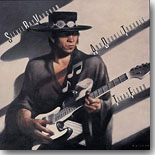
It’s
still hard for me to describe the feeling that I
got when I first heard Stevie Ray Vaughan
way back in the mid ’80s. I had started
listening to Jimi Hendrix a few years earlier,
along with Eric Clapton. I was vaguely familiar
with the blues via what I had heard on TV: B.B.
King on The Tonight Show and the various musical
artists that appeared on Sanford and Son, one of
my favorite shows of the ’70s. But my first real
exposure to the blues was courtesy of SRV’s
first couple of albums, at least that was the
point at which I started paying attention to the
blues.
When
Vaughan and Double Trouble recorded what would
become their debut, Texas Flood (Epic
Records), there was little or no blues being
released on the music scene --- at least on
major labels like Epic. Texas Flood was
the turning point for the blues in the 8’0s, as
far as putting it back in the public eye again.
I can remember seeing Vaughan posters at my
local record store with the album cover as well
as reading articles about Vaughan in various
music magazines. The album spent over six months
on the record charts, which just wasn’t
happening for blues records for years prior to
1983.
I
also remember a lot of critics weren’t overly
enthusiastic about it at the time, which was one
of the reasons that I don’t pay much attention
to critics. Looking back at those reviews now, I
read that Vaughan lacked originality and that he
just sounded like the artists who influenced
him, Albert King and Jimi Hendrix to name a
couple. What the critics probably didn’t realize
at the time was that most of the kids listening
to records probably hadn’t heard very much music
from those two guys and Vaughan was opening
their ears to what was to them a new sound. At
the same time, older music fans who loved those
two artists back during their heyday enjoyed the
chance to hear that kind of music again because
there weren’t a lot of recordings by those
artists, or many like them, lining the record
store shelves at that time.
I was one of those kids
described above. While I’d heard Hendrix, Albert
King was brand new to me, and I loved Vaughan’s
muscular, stinging lead guitar. Later, when I
did hear Albert King, I had a good idea who
provided inspiration to Stevie Ray Vaughan. But
he didn’t just play Albert King, he took what
King played and he
gave it his own coat of paint, if you will --- a
fresh take that took it to another level. For a
kid bored with the same old, same old that I
heard on the radio in the mid-’80s, this was
mighty, mighty music that I knew was going to
stay with me for a long time.
Jackson Browne had heard the band’s 1982 set at
the Montreux Jazz Festival and offered the band
three days of free use of his studio in Los
Angeles where they recorded a demo that was
heard by the legendary John H. Hammond who
passed the demo to Epic Records. The album
itself was recorded in two days, no overdubs,
just like a regular set for the band (Vaughan –
guitar, vocals, Tommy Shannon – bass, Chris
Layton – drums).
Texas Flood kicks off with two SRV
originals, “Love Struck Baby” and “Pride and
Joy,” which happen to be two of Vaughan’s best
and most memorable tunes. “Love Struck Baby”
lasts just over two minutes, but I can remember
rewinding my cassette to listen to it again …..
it blew me away that much. “Pride and Joy” was
Vaughan’s first single, a classic shuffle
written years earlier about his at-the-time lady
friend. It’s still one of his best-loved songs.
Larry Davis’ classic title track is next,
showing what a master Vaughan was at
slow-burning blues. Next up is a sizzling take
of Howlin’ Wolf’s “Tell Me, and then a scorching
instrumental version of the Isley Brother’s
“Testify” (interestingly, Jimi Hendrix played on
the Isley’s version in 1964, one of his first
recording efforts).
“Rude Mood” is another instrumental, a
lightning-fast shuffle, which is followed by a
cover of Buddy Guy’s “Mary Had a Little Lamb,”
which shows the influence of Guy on Vaughan’s
style, but the younger guitarist throws in a few
surprises of his own. “Dirty Pool” is another
splendid slow blues which Vaughan co-wrote with
his former bandmate Doyle Bramhall, one of
several collaborative efforts by the pair over
the years, and the mid-tempo shuffle “I’m Cryin’”
was a sequel of sorts to “Pride and Joy,”
inspired by a later fight with the same lady
friend. The album closes with another
instrumental, “Lenny,” a wonderful, jazzy
tribute to his wife, Lenora.
Texas Flood has been reissued a couple of
times, first in 1999 with three live tracks
attached and a early version of “Tin Pan Alley,”
which was a prominent track on Vaughan’s second
album, Couldn’t Stand The Weather. The
second reissue was in 2013, featuring a bonus
disc of a previously unreleased concert in
Philadelphia from 1983. The original album
release, however, should hold a place in any
current blues fans’ collections as the one that
started the resurgence of the blues as a vital
musical genre.
--- Graham Clarke